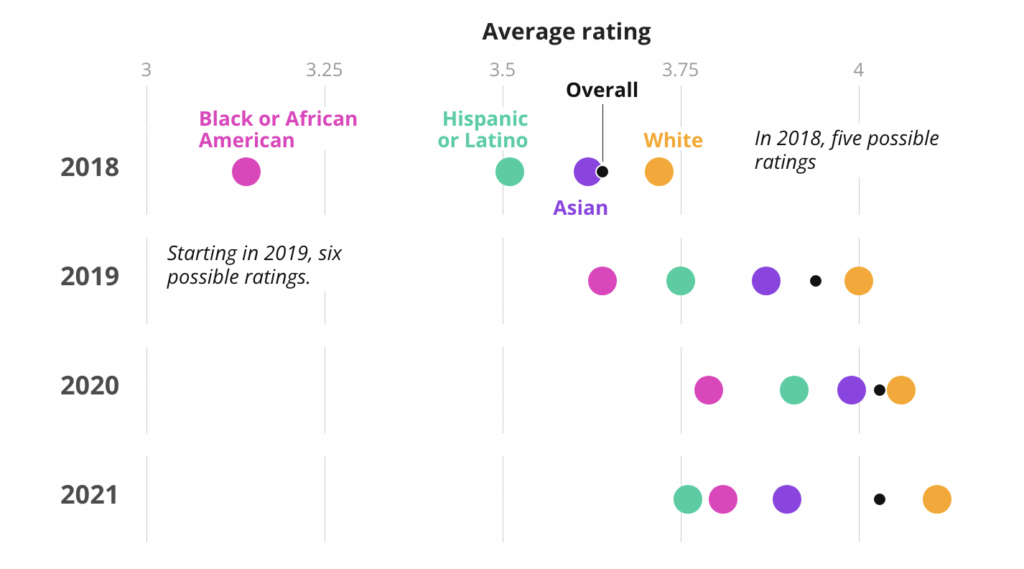This morning, the News Guild of New York published a report detailing information about the New York Times’ internal performance review process, revealing what appears to be a trend of clear bias in favor of the paper’s white employees.
CBS News journalist Wesley Lowery tweeted out a quote from the report that sums up the Guild’s findings.
“The NYT’s performance review system has for years given significantly lower ratings to employees of color…
In 2020, zero Black employees received the highest rating while white employees accounted for more than 90% of ppl who received the top score” https://t.co/2tgKOYGvYf— Wesley (@WesleyLowery) August 23, 2022
“We’re supposed to believe that there was not a single Black (Guild) employee at NYT in 2020 who “Substantially surpasse(d) expectations?”, Lowery tweeted.
Today, @nytimesguild is releasing a report on persistent racial disparities in performance evaluations at @nytimes.
For nearly 2 years, management has chosen to downplay the problem instead of addressing it.https://t.co/CHMWpuTpGL pic.twitter.com/LhM2SGzyuC
— NYTimesGuild (@NYTimesGuild) August 23, 2022
The report found that a previous analysis in 2020 showed that NYT Guild members of color were similarly less likely to be reviewed as favorably as their white counterparts. “Responding a few months later, executives acknowledged that Black employees were underrepresented at the top scores company-wide,” the report explains, “but said that there were no problematic discrepancies when the scores were evaluated separately for each department.”
The racial bias in the review process can be plainly seen in a graph included in the report, detailing performance ratings from 2018 to 2021:

One Black staffer spoke about their experience with the review process, stating that: “although my work consistently performed well with readers and earned high-level praise, my scores did not reflect this…By the time I received my first positive performance review, I’d already concluded that the reviews were unrelated to the quality of my work.”
There’s also, of course, a financial component to the review process. According to the report, “most workers who received the top rating got a 1.9 percent bonus, while those who received a rating of “meets expectations” got 1.5 percent. Employees who got the two lowest ratings received no bonus at all.”
The report also details conflicting evidence about the nature of the rankings themselves, with several employees of color being told that top scores were only applied to workers who were already in line for a promotion and that recently-hired employees could not receive top scores.
In closing, the report finds that: “it is not clear whether the racial imbalance is a result of problems in the performance review system itself or whether that system is simply revealing barriers to success for employees of color at the company.”
While this news might not come as a shock to media workers, who have been aware of the Times’ history of racism and its prioritization of white staffers in terms of safety standards and reporting. In the summer of 2020, during the nationwide Black Lives Matter protests, the Times published an op-ed by conservative Senator Tom Cotton, prompting Black NYT staffers to tweet en masse that the Op-Ed places Black staffers of the paper in direct danger:
Running this puts all black people, including NYT staffers, in danger pic.twitter.com/uWjdYmFHcw
— Aisha Harris (@craftingmystyle) June 3, 2020
Running this put Black @nytimes staff in danger. pic.twitter.com/kBLr3dF2MU
— Jazmine Hughes (@jazzedloon) June 3, 2020
As other commenters have since pointed out, it’s a bit strange to deny Black employees the stamp of excellence in review when one such staffer— the culture writer and NYT critic-at-large Wesley Morris— has won a Pulitzer for his work at the Times. Nikole Hannah Jones, author of the 1619 Project and a Times staff writer, also won a Pulitzer for her work at the paper and in the New York Times Magazine.
This new data comes as a shock to precisely no one, especially those aware of the paper’s continuing history of transphobia and conservative-leaning politics. The question now is whether or not the paper will take this opportunity to address its systemic issues, or continue to ignore them.
Help make sure LGBTQ+ stories are being told...
We can't rely on mainstream media to tell our stories. That's why we don't lock our articles behind a paywall. Will you support our mission with a contribution today?
Cancel anytime · Proudly LGBTQ+ owned and operated
Read More in Impact
The Latest on INTO
Subscribe to get a twice-weekly dose of queer news, updates, and insights from the INTO team.
in Your Inbox














